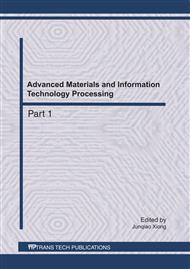[1]
Mario De Blasi, Carlo des Dorides, Advanced solutions for distance learning via satellite, in: computer communications, 26 (2003) 423–429.
DOI: 10.1016/s0140-3664(02)00162-7
Google Scholar
[2]
Karatas, S. (2003). Distance Learning Application in Turkey and in the World, Available from: http: /www. bote. gazi. edu. tr/boteabd/bto309/dunyadaue. ppt, (15. 11. 2008).
Google Scholar
[3]
Kaya, Z. (2002). Distance Training, Available from: http: /www. canaktan. org/egitim/egitim-metodoloji/uzaktan-egitim. htm, (12. 11. 2008).
Google Scholar
[4]
A. Marsap, M. Narin, The integration of distance learning via internet and face to face learning: Why face to face learning is required in distance learning via internet? in: Procedia Social and Behavioral Sciences 1 (2009) 2871–2878.
DOI: 10.1016/j.sbspro.2009.01.510
Google Scholar
[5]
D. Schoder, K. Fischbach, Peer-to-Peer Paradigm, Proc. in: 37th IEEE Int'1 Conference on System Sciences, Hawaii, USA, (2004).
DOI: 10.1109/hicss.2004.1265469
Google Scholar
[6]
E. Ahi, M. Caglar, O. Ozkasap, Stepwise Fair-Share Buffering underneath Bio-inspired P2P Data Dissemination, Proc. in: 6th International Symposium on Parallel and Distributed Computing (ISPDC'07), Hagenberg, Austria, (2007).
DOI: 10.1109/ispdc.2007.54
Google Scholar
[7]
M. Amoretti, A Framework for Evolutionary Peer-to-Peer Overlay Schemes, in: European Workshops on the Applications of Evolutionary Computation (EvoWorkshops 2009), Tubingen, Germany, April (2009).
DOI: 10.1007/978-3-642-01129-0_7
Google Scholar
[8]
Katia Passerini, Mary J. Granger, A developmental model for distance learning using the Internet, in: Computers & Education 34 (2000) 1-15.
DOI: 10.1016/s0360-1315(99)00024-x
Google Scholar
[9]
D.A. Tran, K.A. Hua, T.T. Do, A peer-to-peer architecture for media streaming, in: IEEE Journal on Selected Areas in Communications 22 (1) (2004) 121–133.
DOI: 10.1109/jsac.2003.818803
Google Scholar
[10]
S. Banerjee, B. Bhattacharjee, C. Kommareddy, Scalable application layer multicast, in: SIGCOMM, 2002, p.205–217.
DOI: 10.1145/964725.633045
Google Scholar
[11]
M.B.H. Deshpande, H. Garcia-Molina, Streaming live media over a peer-to-peer network, in: CS-Stanford (2002).
Google Scholar
[12]
V.N. Padmanabhan, H.J. Wang, P.A. Chou, K. Sripanidkulchai, Distributing streaming media content using cooperative networking, in: NOSSDAV, 2002, p.177–186.
DOI: 10.1145/507670.507695
Google Scholar
[13]
Katia Passerini*, Mary J. Granger, Robust video-on-demand streaming in peer-to-peer environments, in: Computer Communications 31 (2008) 506–519.
DOI: 10.1016/j.comcom.2007.08.024
Google Scholar


